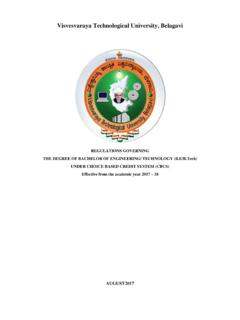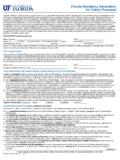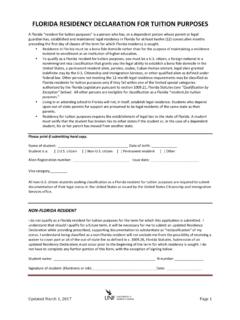Transcription of The University Student Registration System: a Case …
1 The University Student Registration system : a case Study inBuilding a High-Availability Distributed Application Using GeneralPurpose ComponentsM. C. Little, S. M. Wheater, D. B. Ingham, C. R. Snow, H. Whitfield and S. K. ShrivastavaDepartment of Computing Science, Newcastle University ,Newcastle upon Tyne, NE1 7RU, to 1994, Student Registration at Newcastle University involved students being registered in asingle place, where they would present a form which had previously been filled in by the studentand their department. After Registration this information was then transferred to a computerisedformat. The University decided that the entire Registration process was to be computerised for theAutumn of 1994, with the admission and Registration being carried out at the departments of thestudents.
2 Such a system has a very high availability requirement: admissions tutors and secretariesmust be able to access and create Student records (particularly at the start of a new academic yearwhen new students arrive). The Arjuna distributed system has been under development in theDepartment of Computing Science for many years. Arjuna s design aims are to provide tools toassist in the construction of fault-tolerant, highly available distributed applications using atomicactions (atomic transactions) and replication. Arjuna offers the right set of facilities for thisapplication, and its deployment would enable the University to exploit the existing campus networkand workstation clusters, thereby obviating the need for any specialised fault tolerant words: available systems, distributed system , fault-tolerance, atomic transactions, most British Universities, the process of registering all students as members of the institution islargely concentrated into a very short period of time.
3 At the University of Newcastle, the registrationperiod occupies a little over a week in September, at the start of the academic year. The purpose of theregistration process is to determine which students will be taking courses within the University , and forthe administration to keep its records up-to-date. From the students point of view, Registration enablesthem to acquire the necessary authorised membership of the University , and where relevant, obtain theirgrant cheques. It is usually the case that students will register for particular courses, or modules, at thesame time, and the information collected is used by members of the teaching staff to construct classlists, to 1994, Registration involved students being registered in a single place within the University ,where they would present a form which had previously been filled in elsewhere by the Student and theirdepartment.
4 After Registration this information was then transferred to a computer system . In 1993, theUniversity decided that the entire Student Registration process was to be computerised (electronicregistration) for the Autumn of 1994. The decision was also made to decentralise the registrationprocess so that the end users of the course data, the various University departments, would have morecontrol over the accuracy of the data entered. It was also expected that the delay before the final datacould be delivered back to the departments would be considerably reduced. Although the sameregistration forms were issued to students , available data concerning each Student had already beenentered in the system database. At the Registration , using unique Student number as a key, Student datawas retrieved from the database and updated as to say that the Registration process is extremely important to the University and thestudents: the University cannot receive payments for teaching the students , and students cannot receivetheir grants or be taught until they have been registered.
5 Thus the electronic Registration system has avery high availability and consistency requirement; admissions tutors and secretaries must be able toaccess and create Student records (particularly at the start of a new academic year when new studentsarrive). The high availability requirement implies that the computerised Registration system must beable to tolerate a reasonable number of machine and network related failures, and the consistencyrequirement implies that the integrity of stored data ( Student records) must be maintained in thepresence of concurrent access from users and the types of failures just mentioned. It was expected thatmost human errors, such as incorrectly inputting data, would be detected by the system as theyoccurred, but some off-line data manipulation would be necessary for errors which had not beenforeseen.
6 Tolerance against catastrophic failures (such as complete electrical power failure, or a firedestroying much of the University infrastructure) although desirable, was not considered within theremit of the Registration solution that would require the University buying and installing specialist fault-tolerant computingsystems, such as Tandem [1] or Stratus [2] was not considered economically feasible. The only optionworth exploring was exploiting the University 's existing computing resources. Like most otheruniversities, Newcastle has hundreds of networked computers (Unix workstations, PCs, Macs) scatteredthroughout the campus. A solution that could make use of these resources and achieve availability bydeploying software-implemented fault-tolerance techniques certainly looked Arjuna distributed system [3,4,5] has been under development in the Computing ScienceDepartment at the University since 1986.
7 The first public release of the system was made available in1991, and since then the system has been used by a number of academic and commercial organisationsas a vehicle for understanding and experimenting with software implemented fault-tolerance provides a set of tools for the construction of fault-tolerant, distributed applications using atomicactions (atomic transactions) [6] for maintaining consistency of objects and replication of objectsmaintaining availability. Arjuna runs on Unix workstations, so it offered the promise of delivering theavailability and consistency required by the Student Registration system without requiring any specialistcomputing equipment. In the summer of 1994 we (recklessly?) convinced the University to goelectronic and committed ourselves to delivering a system that would run on a cluster of Unixworkstations and provide transactional access to Student records from PC and Macintosh front endmachines located in various paper describes the design and implementation of the Student Registration system built as anArjuna application.
8 The Registration system been in use since October 1994, and during each five dayregistration period approximately 14,000 students are registered. The system illustrates that softwareimplemented fault tolerance techniques can be deployed to build high availability distributedapplications using general-purpose ('off-the-shelf') components such as Unix workstations connected byLANs. Although distributed objects, transactions and replication techniques that have been used hereare well-known in the research literature, we are not aware of any other mission-critical application thatroutinely makes use of them over commonly available hardware/software AssumptionsIt is assumed that the hardware components of the system are computers (nodes), connected by acommunication subsystem.
9 A node is assumed to work either as specified or simply to stop working(crash). After a crash, a node is repaired within a finite amount of time and made active again. A nodemay have both stable (crash-proof) and non-stable (volatile) storage or just non-stable storage. All ofthe data stored on volatile storage is assumed to be lost when a crash occurs; any data stored on stablestorage remains unaffected by a communication environment can be modeled as either asynchronous or synchronous. In anasynchronous environment message transmission times cannot be estimated accurately, and theunderlying network may well get partitioned ( , due to a crash of a gateway node and/or networkcongestion) preventing functioning processes from communicating with each other; in such anenvironment, timeouts and network level ping mechanisms cannot act as an accurate indication ofnode failures (they can only be used for suspecting failures).
10 We will call such a communicationenvironment partitionable. In a synchronous communication environment, functioning nodes arecapable of communicating with each other, and judiciously chosen timeouts together with network level ping mechanisms can act as an accurate indication of node failures. We will call such acommunication environment Student Registration system can be viewed as composed of two sub-systems: the Arjuna sub- system that runs on a cluster of Unix workstations and is responsible for storing and manipulatingstudent data using transactions, and the front-end sub- system , the collection of PCs and Macs eachrunning a menu driven graphical user interface that users employ to access Student data through theArjuna sub- system (see fig.)








